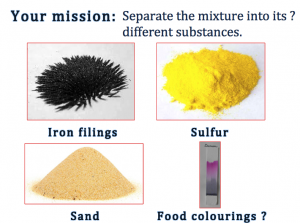Separating mixtures: techniques teaching resources
Worksheets and lesson ideas to challenge students aged 11 to 16 to think hard about separating mixtures (GCSE and Key Stage 3)
Overview: Separating techniques(chromatography, distillation, filtration and crystallisation) provide an excellent opportunity for students to apply their learning from the particle model, elements compounds and mixtures, state changes and conservation of mass. The practical nature of this topic also allows students to experience important ideas for themselves e.g. seeing a liquid form from an apparently ’empty’ tube in distillation. That said, there is a real need to ensure a careful balance is struck between the procedural demands of the practical and the conceptual demands of the science. If students are asked to think about both the science and how to do the practical work at the same time there is a risk that they will do neither well. Wherever possible, use the particle model to help explain how these methods work – zooming here is an important skill.
Key concept: a mixture can be separated according to the different physical properties of the substances that it contains.
From big idea: All matter in the Universe is made of very small particles
Linked knowledge: elements and compounds, heat and temperature, bonding, particle model and states of matter, conservation of matter
Misconception/error [scientific idea]: a mixture is one substance [a mixture is made up from various substances that are not chemically bonded]; society uses the word pure in the same way as a scientist [pure for a scientist means made from only one substance].
Teaching resources
The resources below should only be used after all the separation techniques have been taught.
 Selecting the appropriate separating technique
Selecting the appropriate separating technique
GCSE activity where students select the appropriate separating technique. Students select the appropriate technique to separate mixtures by chromatography, distillation, fractional distillation, filtration and crystallisation. It finishes with a really challenging question that asks students to suggest ideas on how to separate copper from a mixture containing magnesium, salt, water and copper. (PDF)
The separation challenge!
Students are given a range of practical equipment and work in pairs to separate a complex mixture containing sand, sulfur, two food dyes and iron. This activity was made in collaboration with Claire Couves and Rownok Jahan. Please conduct your own risk assessment before carrying out this practical.
Getting students to assemble different apparatus to separate different mixtures
Chemix is a free website that allows you to assemble pieces of common lab apparatus together. You could ask students to use this website to assemble apparatus to separate different mixtures. They could then export images and submit these for feedback.
Further reading
Green, J.B. (2018). How to teach separation techniques. Education in Chemistry Blog.
